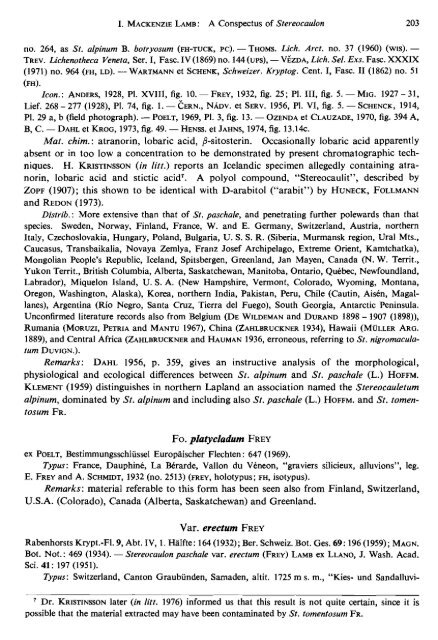A CONSPECTUS OF THE LICHEN GENUS STEREOCAULON ...
A CONSPECTUS OF THE LICHEN GENUS STEREOCAULON ...
A CONSPECTUS OF THE LICHEN GENUS STEREOCAULON ...
You also want an ePaper? Increase the reach of your titles
YUMPU automatically turns print PDFs into web optimized ePapers that Google loves.
I. MACKENZIE LAMB: A Conspectus of Stereocaulon 203<br />
no. 264, as St. alpinum B. botryosum (FH-TUCK, PC). - THOMS. Lich. Arct. no. 37 (1960) (WIS). -<br />
TREV. Lichenotheca Veneta, Ser. I, Fasc. IV (1869) no. 144 (ups), - V~ZDA, Lich. Sel. Exs. Fasc. XXXIX<br />
(1971) no. 964 (FH, LD). - WARTMANN et SCHENK, Schweizer. Kryptog. Cent. I, Fasc. I1 (1862) no. 51<br />
(FH).<br />
Icon. : ANDERS, 1928, PI. XVIII, fig. 10. - FREY, 1932, fig. 25; PI. 111, fig. 5. - MIG. 1927 - 31,<br />
Lief. 268 - 277 (1928), PI. 74, fig. 1. - CERN., NADV. et SERV. 1956, PI. VI, fig. 5. - SCHENCK, 1914,<br />
PI. 29 a, b (field photograph). - POELT, 1969, PI. 3, fig. 13. - OZENDA et CLAUZADE, 1970, fig. 394 A,<br />
B, C. - DAHL et KRoG, 1973, fig. 49. - HENSS. et JAHNS, 1974, fig. 13.14~.<br />
Mat. chim.: atranorin, lobaric acid, B-sitosterin. Occasionally lobaric acid apparently<br />
absent or in too low a concentration to be demonstrated by present chromatographic techniques.<br />
H. KRISTINSSON (in litt.) reports an Icelandic specimen allegedly containing atranorin,<br />
lobaric acid and stictic acid7. A polyol compound, "Stereocaulit", described by<br />
ZOPF (1907); this shown to be identical with D-arabitol ("arabit") by HUNECK, FOLLMANN<br />
and REDON (1973).<br />
Distrib.: More extensive than that of St. paschale, and penetrating further polewards than that<br />
species. Sweden, Norway, Finland, France, W. and E. Germany, Switzerland, Austria, northern<br />
Italy, Czechoslovakia, Hungary, Poland, Bulgaria, U. S. S. R. (Siberia, Murmansk region, Ural Mts.,<br />
Caucasus, Transbaikalia, Novaya Zemlya, Franz Josef Archipelago, Extreme Orient, Kamtchatka),<br />
Mongolian People's Republic, Iceland, Spitsbergen, Greenland, Jan Mayen, Canada (N. W. Territ.,<br />
Yukon Territ., British Columbia, Alberta, Saskatchewan, Manitoba, Ontario, Quebec, Newfoundland,<br />
Labrador), Miquelon Island, U. S. A. (New Hampshire, Vermont, Colorado, Wyoming, Montana,<br />
Oregon, Washington, Alaska), Korea, northern India, Pakistan, Peru, Chile (Cautin, Aiskn, Magallanes),<br />
Argentina (Rio Negro, Santa Cruz, Tierra del Fuego), South Georgia, Antarctic Peninsula.<br />
Unconfirmed literature records also from Belgium (DE WILDEMAN and DURAND 1898 - 1907 (1898)),<br />
Rumania (MORUZI, PETRIA and MANTU 1967), China (ZAHLBRUCKNER 1934), Hawaii (MULLER ARG.<br />
1889), and Central Africa (ZAHLBRUCKNER and HAUMAN 1936, erroneous, referring to St. nigromaculatum<br />
DUVIGN.).<br />
Remarks: DAHL 1956, p. 359, gives an instructive analysis of the morphological,<br />
physiological and ecological differences between St. alpinum and St. paschale (L.) H<strong>OF</strong>FM.<br />
KLEMENT (1959) distinguishes in northern Lapland an association named the Stereocauletum<br />
alpinum, dominated by St. alpinum and including also St. paschale (L.) H<strong>OF</strong>FM. and St. tomentosum<br />
FR.<br />
Fo. platycladum FREY<br />
ex POELT, Bestimmungsschliis~e1 Europaischer Flechten: 647 (1969).<br />
Typus: France, Dauphine, La Bkrarde, Vallon du Veneon, "graviers silicieux, alluvions", leg.<br />
E. FREY and A. SCHMIDT, 1932 (no. 2513) (FREY, holotypus; FH, isotypus).<br />
Remarks: material referable to this form has been seen also from Finland, Switzerland,<br />
U.S.A. (Colorado), Canada (Alberta, Saskatchewan) and Greenland.<br />
Var. erectum FREY<br />
Rabenhorsts Krypt.-F1.9, Abt. IV, 1. Halfte: 164 (1932); Ber. Schweiz. Bot. Ges. 69: 196 (1959); MAGN.<br />
Bot. Not.: 469 (1934). - Stereocaulon paschale var. erectum (FREY) LAMB ex LLANO, J. Wash. Acad.<br />
Sci. 41: 197 (1951).<br />
Typus: Switzerland, Canton Graubiinden, Sarnaden, altit. 1725 m s. m., "Kies- und Sandalluvi-<br />
Dr. KRISTINSSON<br />
later (in litt. 1976) informed us that this result is not quite certain, since it is<br />
possible that the material extracted may have been contaminated by St. tomentosum FR.

















